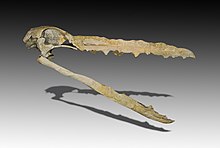齒雁類
齒雁類(學名:Odontoanserae)是一個包涵了齒翼鳥目與雁形類(雁形目及其近親)的分類單元。[2]齒翼鳥類的演化地位一直存在爭議,除此觀點外,也有人憑藉其胸骨形態的特點將其視為鸌形目或鵜形目的近親。[3]
| 齒雁類 | |
|---|---|

| |

| |
| 毛利塔尼亞遠洋鳥的頭骨化石(上)與普通秋沙鴨的頭部照片,兩者有所相似 | |
| 科學分類 | |
| 界: | 動物界 Animalia |
| 門: | 脊索動物門 Chordata |
| 綱: | 鳥綱 Aves |
| 演化支: | 今顎類 Neognathae |
| 演化支: | 泛雞雁類 Pangalloanserae |
| 小綱: | 雞雁小綱 Galloanserae |
| 演化支: | 齒雁類 Odontoanserae Bourdon, 2005 |
| 亞群 | |
2005年的研究表明,因為相同的顱骨特徵,齒翼鳥類應當作為雁形類的姊妹群。[4]除此之外,兩者在骨盆和胸骨也存在着很多相似特徵。此外,2013年對遠洋鳥偽齒的研究表明,兩者都有「軟質嘴鞘,或嘴鞘延遲發育」的現象發生,進一步支持了齒雁類的單系性。[5]除了齒翼鳥目和雁形目之外,學者也支持將馳鳥科和加斯頓鳥科放入這一分類單元,這兩類鳥與雁形目有着相似的頭骨和骨盆的解剖學特徵。[6][7][8]馳鳥與加斯頓鳥相較於齒翼鳥類更接近於雁形目。一種觀點認為加斯頓鳥與馳鳥組成單系群,作為雁形目的姊妹群,另一種說法則認為馳鳥與雁形目中的叫鴨科關係更近。[7]
下列為齒雁類系統發育的通常共識。[7][4][8][9][10]
| 齒雁類 |
| ||||||||||||||||||||||||
然而,沃西(Worthy)和他的同事在2017年的一篇論文中發現了一種關於雁形類的另類系統關係。[11]通過添加新的特徵,以及將幾個新的分類群合併到已建立的矩陣中,作者發現加斯頓鳥類和馳鳥類應當作為姊妹群,可以一同放在加斯頓鳥形目中。[12]此外,他們還發現了一種支持,即維加鳥科(通常被歸類為基幹雁形目或作為其姊妹分類單元[10])與加斯頓鳥目的關係比與雁形目的關係更密切;因此,他們創造了單系群維加鳥目。[12] 作者們確實注意到,引導支持的是弱支持,他們的論文中的幾個替代用的系統發育也表明加斯頓鳥類也有可能是基幹雞形目,這些也得到了微弱的支持。[12]
下面是一個簡化的系統發育圖,顯示了他們支持冠恐鳥形目與維加鳥目結合組成雁形目的姊妹群。[12]
| 齒雁類 |
| ||||||||||||||||||
2019年,發現於南極早古新世沉積物的新物種南極衝突鳥得到了描述。[1]Tambussi等人於2019年使用Worthy等人於2017年的基礎數據將這一新類群納入系統發育分析。他們的研究結果不僅支持了維加鳥類與加斯頓鳥類和馳鳥類的姐妹群關係(將維加鳥科納入加斯頓鳥目),而且還發現了傳統上被認為是狹義雁形目的兩個類群,君王鴨翼鳥和普瑞斯比鳥科,[13]其實是干群雁形目。[1]
下面是Tambussi等人於2019年建立的系統發育。[1]
| 雁形類 |
| |||||||||||||||||||||||||||||||||||||||
參考來源
編輯- ^ 1.0 1.1 1.2 1.3 Claudia P. Tambussi; Federico J. Degrange; Ricardo S. De Mendoza; Emilia Sferco; Sergrio Santillana. A stem anseriform from the early Palaeocene of Antarctica provides new key evidence in the early evolution of waterfowl. Zoological Journal of the Linnean Society. 2019, 186 (3): 673–700. doi:10.1093/zoolinnean/zly085.
- ^ Bourdon, E. Osteological evidence for sister group relationship between pseudo-toothed birds (Aves: Odontopterygiformes) and waterfowls (Anseriformes). Naturwissenschaften. 2005, 92 (12): 586–91. Bibcode:2005NW.....92..586B. PMID 16240103. S2CID 9453177. doi:10.1007/s00114-005-0047-0.
- ^ Mayr, G.; Hazevoet, C.J.; Dantas, P.; Cachão, M. A Sternum of a Very Large Bony-Toothed Bird (Pelagornithidae) from the Miocene of Portugal. Journal of Vertebrate Paleontology. 2008, 28 (3): 762–769. doi:10.1671/0272-4634(2008)28[762:asoavl]2.0.co;2.
- ^ 4.0 4.1 Bourdon, E. Osteological evidence for sister group relationship between pseudo-toothed birds (Aves: Odontopterygiformes) and waterfowls (Anseriformes). Naturwissenschaften. 2005, 92 (12): 586–91. Bibcode:2005NW.....92..586B. PMID 16240103. S2CID 9453177. doi:10.1007/s00114-005-0047-0.
- ^ Louchart, A.; Sire, J.-Y.; Mourer-Chauviré, C.; Geraads, D.; Viriot, L.; de Buffrénil, V. Structure and Growth Pattern of Pseudoteeth in Pelagornis mauretanicus (Aves, Odontopterygiformes, Pelagornithidae). PLOS ONE. 2013, 8 (11): e80372. Bibcode:2013PLoSO...880372L. PMC 3828250 . PMID 24244680. doi:10.1371/journal.pone.0080372 .
- ^ Andors, A. Reappraisal of the Eocene groundbird Diatryma (Aves: Anserimorphae). Science Series Natural History Museum of Los Angeles County. 1992, 36: 109–125.
- ^ 7.0 7.1 7.2 Murrary, P.F; Vickers-Rich, P. Magnificent Mihirungs: The Colossal Flightless Birds of the Australian Dreamtime. Indiana University Press. 2004.
- ^ 8.0 8.1 Agnolín, F. Brontornis burmeisteri Moreno & Mercerat, un Anseriformes (Aves) gigante del Mioceno Medio de Patagonia, Argentina.. Revista del Museo Argentino de Ciencias Naturales. 2007, 9: 15–25. doi:10.22179/revmacn.9.361 .
- ^ Livezey, B.C.; Zusi, R.L. Higher-order phylogeny of modern birds (Theropoda, Aves: Neornithes) based on comparative anatomy. II. Analysis and discussion. The Science of Nature. 2007, 149 (1): 1–95. PMC 2517308 . PMID 18784798. doi:10.1111/j.1096-3642.2006.00293.x.
- ^ 10.0 10.1 Agnolín, F.L.; Egli, F.B.; Chatterjee, S.; Marsà, J.A.G. Vegaviidae, a new clade of southern diving birds that survived the K/T boundary. The Science of Nature. 2017, 104 (87): 87. Bibcode:2017SciNa.104...87A. PMID 28988276. S2CID 13246547. doi:10.1007/s00114-017-1508-y.
- ^ Worthy, T.H.; Degrange, F.J.; Handley, W.D.; Lee, M.S.Y. The evolution of giant flightless birds and novel phylogenetic relationships for extinct fowl (Aves, Galloanseres). Royal Society Open Science. 2017, 11 (10): 170975. Bibcode:2017RSOS....470975W. PMC 5666277 . PMID 29134094. doi:10.1098/rsos.170975.
- ^ 12.0 12.1 12.2 12.3 Worthy, T.H.; Degrange, F.J.; Handley, W.D.; Lee, M.S.Y. The evolution of giant flightless birds and novel phylogenetic relationships for extinct fowl (Aves, Galloanseres). Royal Society Open Science. 2017, 11 (10): 170975. Bibcode:2017RSOS....470975W. PMC 5666277 . PMID 29134094. doi:10.1098/rsos.170975.
- ^ Vanesa L. De Pietri; R. Paul Scofield; Nikita Zelenkov; Walter E. Boles; Trevor H. Worthy. The unexpected survival of an ancient lineage of anseriform birds into the Neogene of Australia: the youngest record of Presbyornithidae. Royal Society Open Science. 2016, 3 (2): 150635. Bibcode:2016RSOS....350635D. PMC 4785986 . PMID 26998335. doi:10.1098/rsos.150635.








